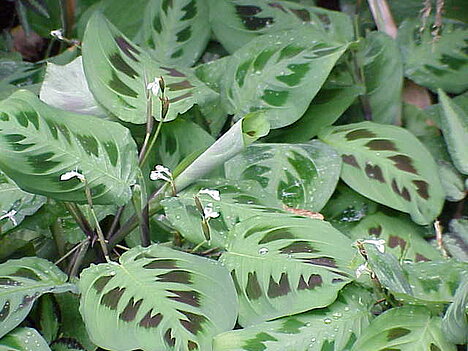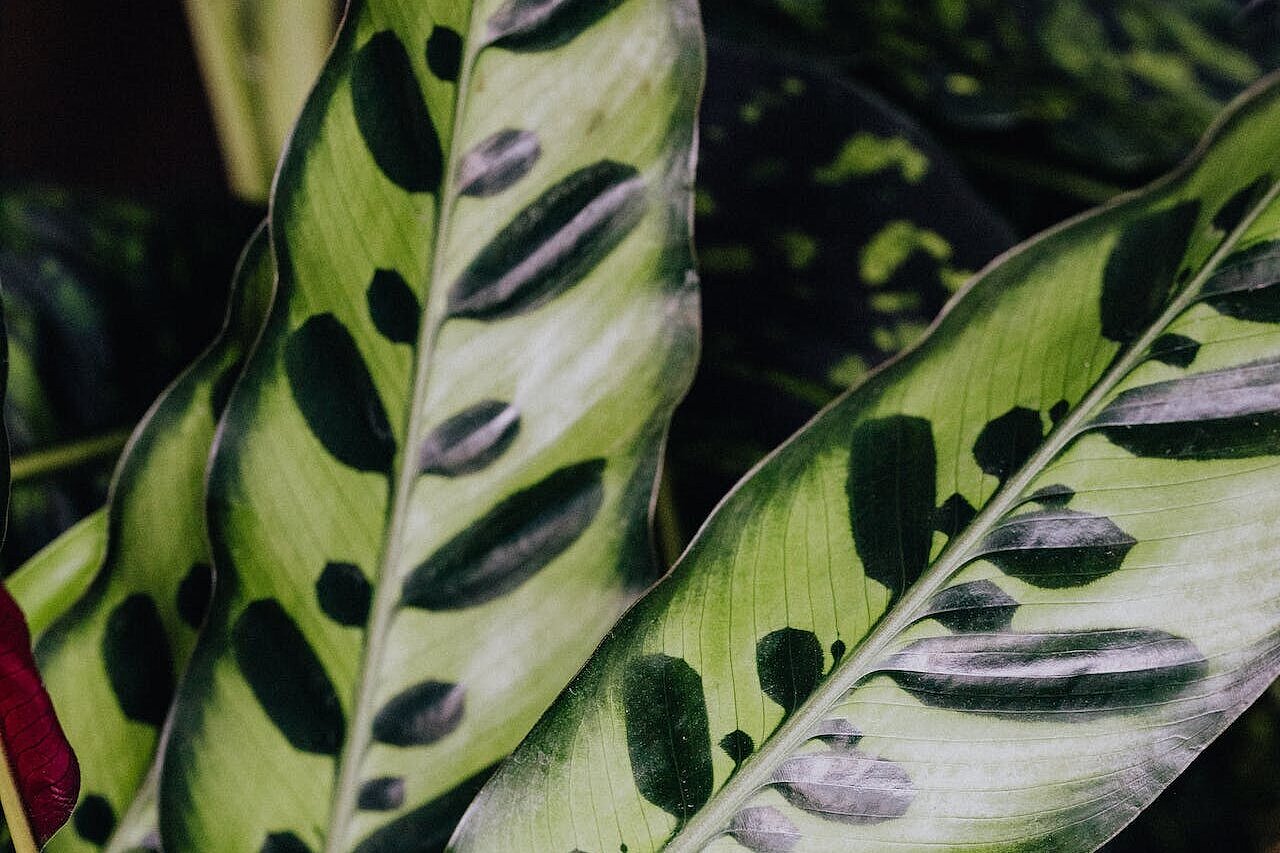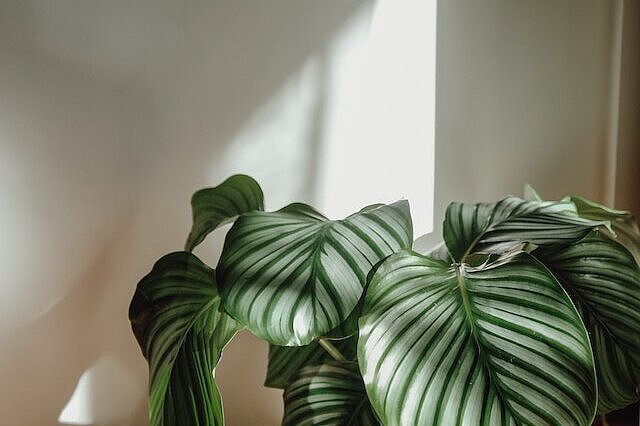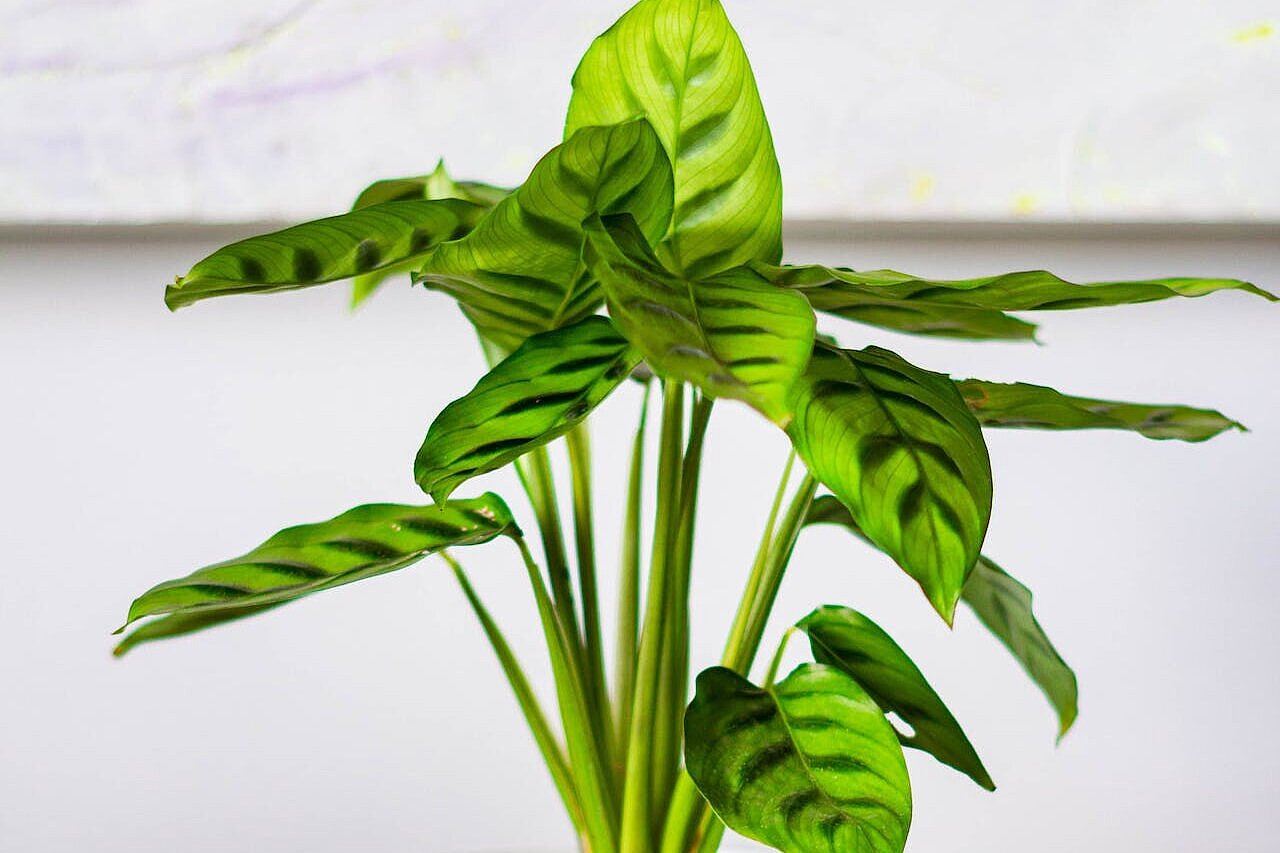Calathea libbyana

What is Calathea libbyana?
Calathea libbyana is an evergreen, rhizome-forming perennial that thrives under the dense canopy of tropical forests. It forms egg-shaped, shiny and long-stalked leaves that are colored in various shades of green and have fine light green or pink lines. The underside of the leaves is often purple or red in color. The leaves are not only decorative, but also lively: They fold up every evening and unfold again every morning. This phenomenon is known as nastia and serves to adapt to the light conditions in the forest.
Calathea libbyana is not only an ornamental foliage plant, but can also produce attractive flowers. These appear as upright spikes in racemes and have a tubular shape with widened upper and lower lips. The flowers are usually white, pink or purple in color and have a pleasant fragrance. Small capsules with seeds develop from the flowers, but these rarely germinate.
Calathea libbyana is a popular houseplant that brings a tropical flair to any home. However, it is also a demanding plant that requires a lot of care and attention to maintain its beauty.
How do you plant and care for Calathea libbyana?
To successfully cultivate Calathea libbyana, you need to mimic its natural conditions as closely as possible. Above all, this means providing it with a semi-shady location, high humidity, a well-drained substrate and sufficient watering.
Location
Calathea libbyana can cope with relatively little light, as it grows under a dense canopy in its native habitat. However, it should not be placed in too dark a location, as otherwise its leaf pattern may fade. An east or west-facing window is ideal, as it does not tolerate direct sunlight. You can also place it in a bathroom or kitchen where the humidity is higher.
Substrate
Calathea libbyana needs a substrate with good permeability so that its roots do not stand in water. You can use a standard potting soil or make your own mixture of peat, sand and perlite. The substrate should have a pH value between 4.5 and 5.5, as Calathea libbyana prefers acidic soil.
Watering
Calathea libbyana likes it moist, but not wet. You should water it regularly, but make sure that the substrate dries out slightly between waterings. Avoid waterlogging as this can lead to root rot. It is best to use soft water or rainwater, as chalky water can damage the leaves.
Air humidity
Calathea libbyana loves high humidity of at least 60 percent. You can use several methods to achieve this:
- Spray the leaves daily with soft water or rainwater
- Place the plant on a tray filled with water and gravel or expanded clay so that the pot is not standing in water
- Group several plants together to create a microclimate
- Use a humidifier or place the plant near a shower or aquarium
Temperature
Calathea libbyana prefers a warm and constant temperature between 20 and 25 degrees Celsius. It does not tolerate draughts or frost and should not fall below 15 degrees Celsius in winter.
Fertilizing
Calathea libbyana does not need much fertilizer as it grows in nutrient-poor soil in its native habitat. However, you can give it a diluted liquid fertilizer for houseplants every two weeks from spring to autumn to promote its growth and flowering. Avoid over-fertilizing, however, as this can lead to salt deposits in the substrate.
Repotting
Calathea libbyana grows relatively slowly and therefore does not need to be repotted often. You can repot it every two to three years in a slightly larger pot with fresh substrate to aerate its roots. The best time to do this is in spring, before the plant enters the growth phase.
Pruning
Calathea libbyana does not need to be pruned, except to remove dead or damaged leaves and flowers. You can do this with clean and sharp scissors to avoid infection.
Propagation
The easiest way to propagate Calathea libbyana is by division. You can do this when repotting by carefully removing the plant from the pot and dividing the roots with your hands or a knife. Make sure that each plant has at least two to three leaves. Plant the subplants in separate pots with fresh substrate and water them well. Keep them warm and moist until they have formed new roots.
Another option is propagation by cuttings. You can cut off a healthy leaf with a piece of stem and place it in a glass of water. Change the water regularly and wait until roots have formed. Then you can plant the cutting in a pot with substrate.
Why is Calathea libbyana suitable for dogs?
Calathea libbyana is a dog-friendly houseplant because it does not contain any toxic substances. On the contrary, it even has air-purifying properties and can filter pollutants such as formaldehyde or benzene out of the air. This is not only good for you, but also for your dog.
Calathea libbyana is also an attractive plant that your dog might like. It has soft and shiny leaves that invite your dog to play. It also makes noises when it folds or unfolds its leaves, which might make your dog curious.
Of course, you should still make sure that your dog doesn't eat too much of the plant or damage it. Too much greenery can cause stomach upsets and the leaves can have sharp edges that could injure your dog's mouth. It would also be a shame if your beautiful Calathea libbyana was destroyed.
Calathea libbyana is an exotic houseplant that delights with its diverse colors and leaf patterns. However, it is also a demanding plant that requires a lot of care and attention.
Properties 2
Are you looking for other ingredients with a specific property?
Just click on them to find more.
If you notice any signs of hypersensitivity or poisoning in your dog, you should see your vet immediately. We are not a substitute for a vet, but we try to be as accurate as possible. Every dog reacts differently and we recommend you get a second opinion or consult your vet if in doubt.
Stay healthy and take good care of your four-legged friend!😊
Similar to Calathea libbyana
Calathea lancifolia belongs to the Marantaceae family, which is known for its diverse and decorative leaf patterns. The plant is characterized by its long, lancet-shaped leaves, which have unique...
Calathea Orbifolia is a species of the genus Calathea, which belongs to the arrowroot family (Marantaceae)1. It originates from the tropical forests of South America and has striking, round to oval...
Calathea zebrina is an evergreen perennial that grows from rhizomes and reaches a height of up to one meter. The leaves sit on long, fleshy stems and are oblong-oval in shape. They can grow to over...
Calathea roseopicta is a demanding houseplant that needs plenty of moisture, warmth and light. It should be placed in a bright, but not directly sunny spot, otherwise the leaves may burn. The...



